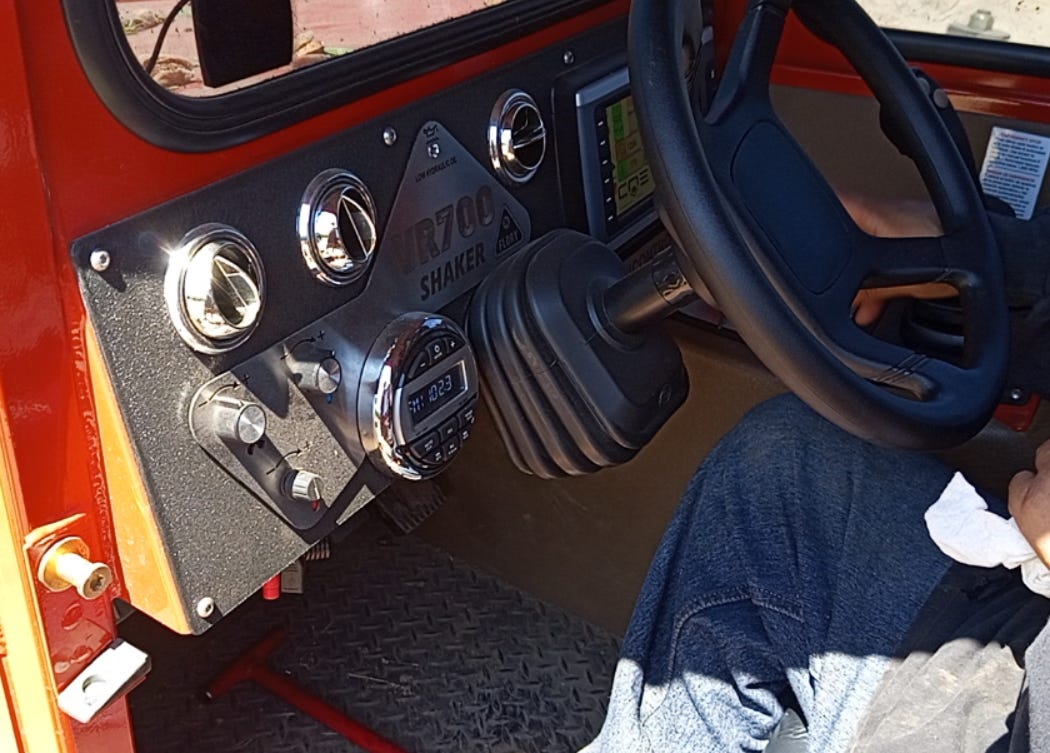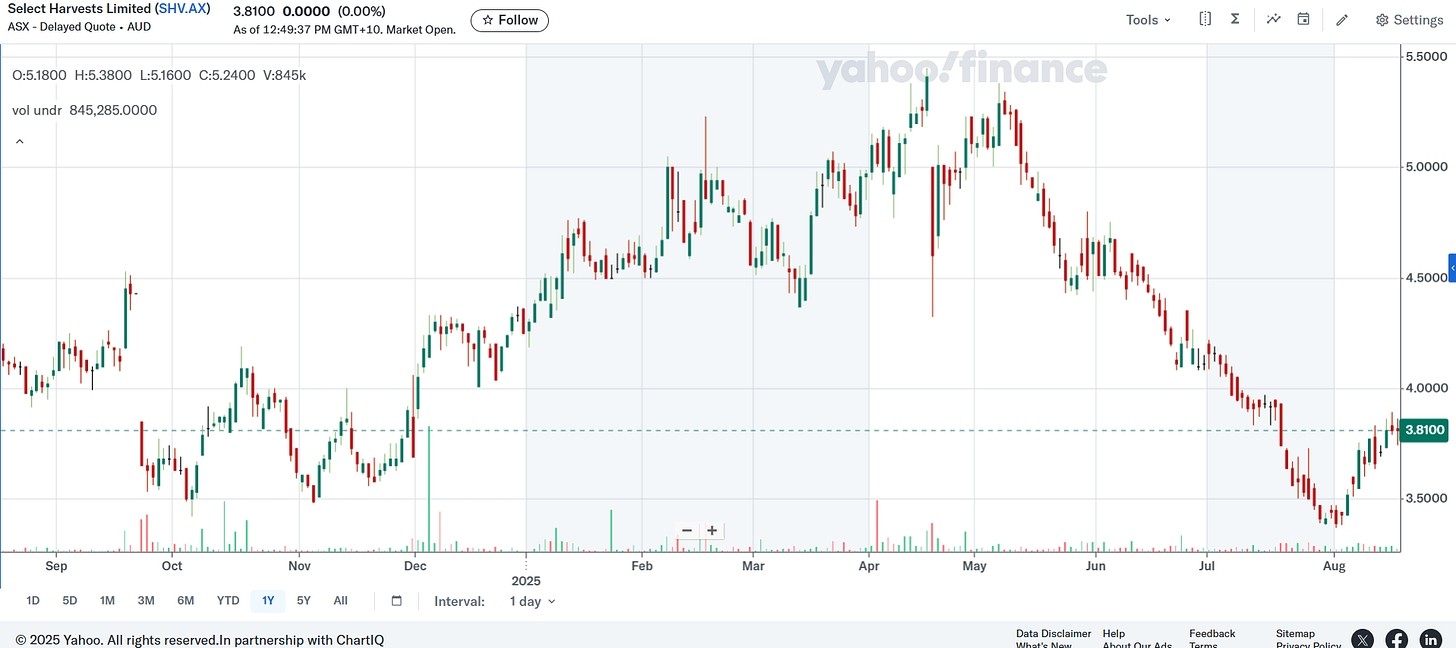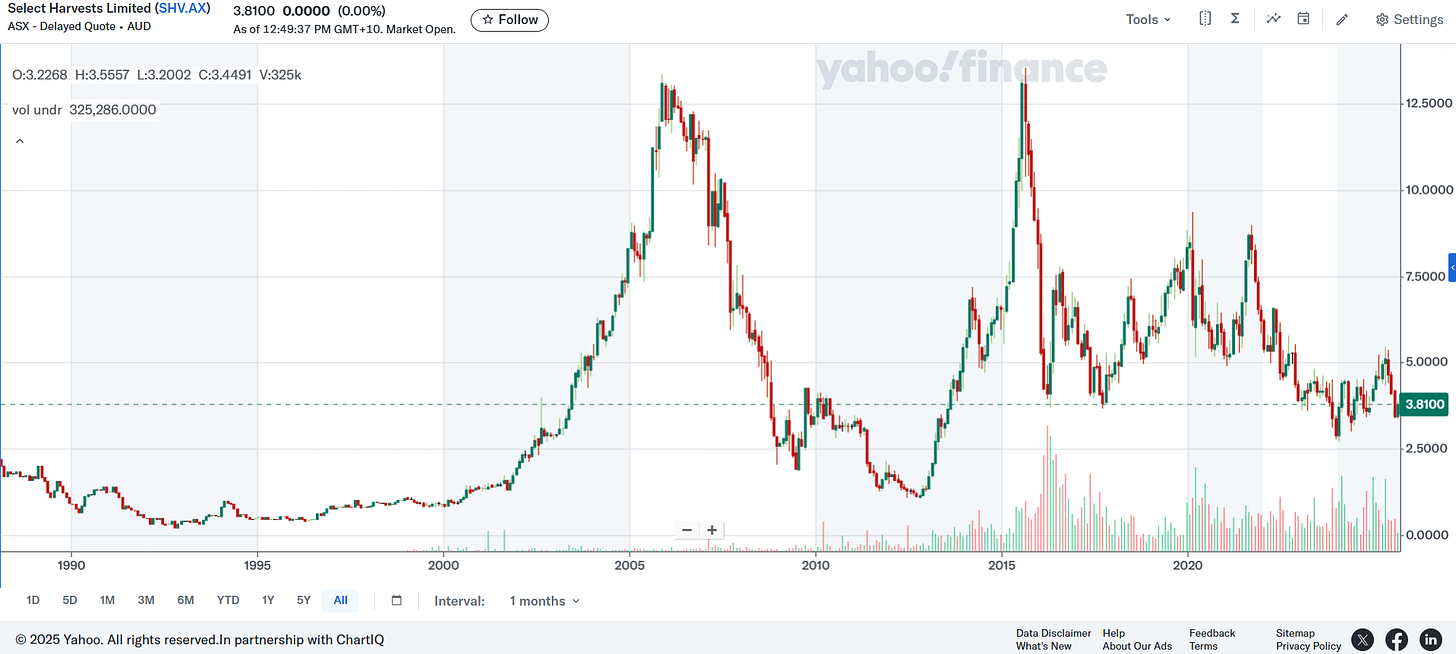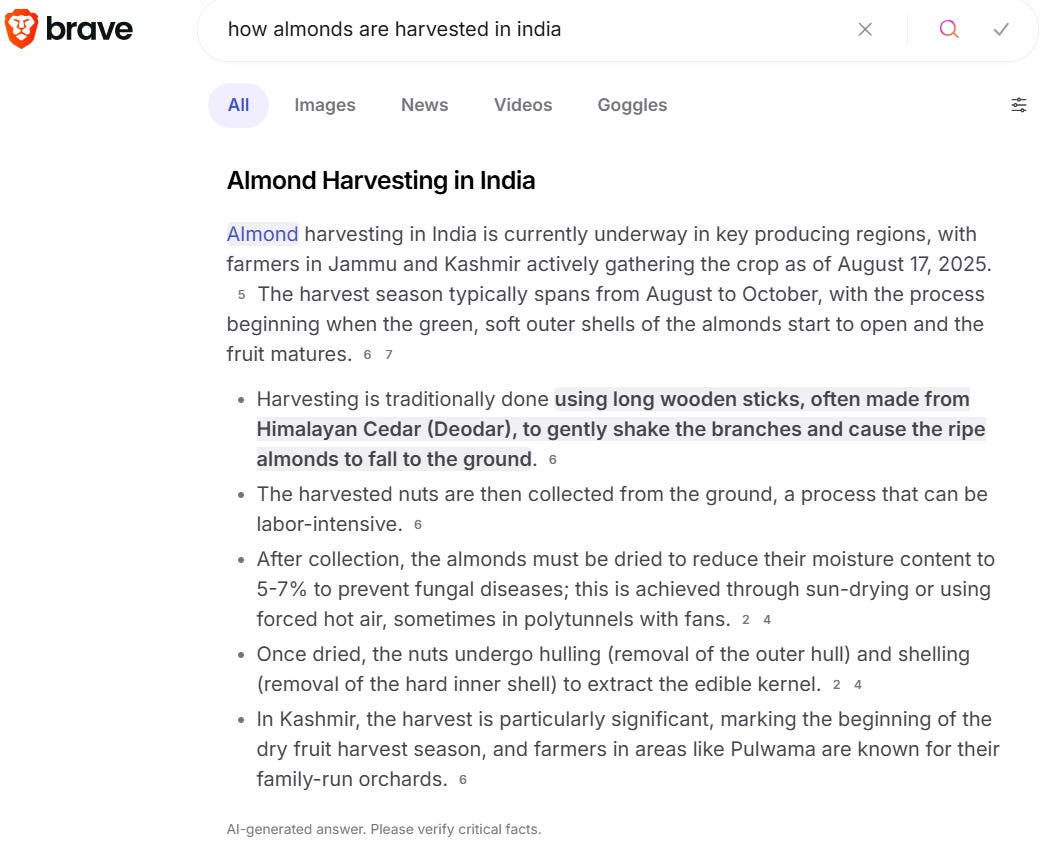As mentioned last Monday, I am in California for the almond harvest and to illustrate the difficulties of competing with capital/tech intensive American agriculture or for countries like India (who grow almonds and other nuts) to be willing to open up their markets to American competition – this is some of the equipment being used:

That’s easily several hundred thousand dollars worth of relatively new harvesting equipment that will only be used to harvest almonds (and maybe for some walnuts) plus knock mummy nuts off trees in the winter and will otherwise sit idle for the rest of the year.
The farmer who owns the equipment leases the land next door (and planted an orchard on it) plus he has his own acreage (with at-least 30,000+ trees of his own) and a fairly new almond huller to remove nut hulls – I suspect the lingering Trump tax cuts from his first term has something to do with all the fairly new equipment…
Note that the equipment is made locally (by, I assume, still locally family owned businesses, unless they owned by private equity now…) as yes, there is still manufacturing in the USA and still some survivors in California. India and China (who also grows walnuts) could probably make cheaper equipment (and I think alot of nut/food processing related equipment still comes from Spain, Israel, etc.), but I still doubt it would be of this calibre e.g. the shaker has a small screen where tree spacing and other info is entered while the cab is airconditioned and has a button to suck out any dust should it start to get dusty inside:

Meanwhile, in India:
And that’s why Trump was not able to negotiate a better trade deal with India that included California almonds and other nut products…
When my great grandparents planted a walnut orchard on the property in the late 1930s or 1940s, I’m guessing wooden poles were still being used (or at least that’s probably what was being used in Southern Europe well into recent times) or some very simple mechanical shakers and sweepers for harvesting.
Note that the nuts on my couple of thousand irrigated almond trees have largely come off both this year and last year which could be due to the new shaker or the hotter/drier weather (the first 2 harvests were during wet El Niño years and it seemed like many nuts remained stuck to the trees).
But I have still been walking around with a small pole for spots in the orchard where they are sticking to the trees (as they will get infested with worms that will infect the next crop should they not come off in the winter) and then raking the edges to prepare for the (blue) sweeper equipment. In India though, the average orchard size is probably much smaller than what I am dealing with (and more labor intensive).
However and when the tree shaking was done on Friday, we chatted with the driver who talked about shaking almond orchards so badly maintained that no nuts came off some trees because they had nothing but suckers growing out of them due to the lack of pruning. And at another orchard, 70 trees simply fell over (as the ground around them had eroded from irrigation and from not being properly maintained).
A neighbour with an orchard next door who used to travel for his work has observed how down south they don’t like to prune the trees to the point where they turn into bushes. I guess the mentality down there is to just get as many nuts off the trees (but if you don’t prune the middles, the nuts there will stick to the trees or the green hulls will not crack open due to the lack of sunlight) and then just rip the orchard out, take some tax deductions/losses, and plant a new one…
I do have to wonder whether some of the orchards the shaker driver talked about are actually owned by private equity. My March 10, 2024 post discussed the problems they have caused the almond industry as some of their almond farm owning entities, which had university endowments/foundations/wealthy celebrities as investors, have been pushed into bankruptcy due in part to floating rate loans (and with anything of value, like water rights, no doubt already siphoned off to related entities controlled by the private equity insiders themselves…). Rabo Agrifinance (a subsidiary of Netherlands based Rabobank Group and one of the biggest ag financers in the world) is also heavily involved in almonds and almond financing.
Almond farmers and buyers at this time of the year also have to contend with annual USDA objective forecast for the incoming crop size. As with many economic stats or forecasts coming out of the US government in recent years, these have been increasingly inaccurate and less and less believable by repeatedly overstating the size of the incoming crop which causes prices to immediately crater (which naturally benefits big almond buyers at the expense of farmers).
This time around, prices cratered by almost US$1 a pound (e.g. California almond growers question crop forecast) and my buyer noted in their latest update that this price drop was the largest and quickest fall in almond history (their phones largely stopped ringing for about 2 weeks). But then prices quickly rebounded as sales resumed (and no doubt as buyers started doing their own due diligence with those on the ground to assess the actual incoming crop size…).
Shares of Select Harvests Ltd (ASX: SHV / FRA: H0I / OTCMKTS: SHVTF), the largest almond grower in Australia and the only listed “almond stock,” also dipped after the USDA forecast, but have mostly recovered – another sign that fewer people are believing USDA forecasts (after their initial shock wears off):

Note that over the longer term though, Select Harvests’ performance has been mixed and may also reflect the performance of the AUD:

I should note that the USDA has just done the same routine to corn farmers – a much bigger and more important American industry plus investors or speculators can trade corn futures:
📰 USDA Shocks the Market With Its Eye-Popping Corn Yield: Is This The Highest Yield of the Season? (Farm Journal) August 2025
If USDA predictions hold true, a massive U.S. corn crop is on the way.
I don’t know anything about the corn market and maybe the American corn crop will be huge this season…
But with so many American congressmen somehow becoming successful stock traders along with other government officials who are part of the US military industrial complex being equally talented investors in, for example, early stage tech or defense related stocks/investments, one has to be cynical and start to wonder what could be going on at the USDA with their crop forecasts (along with what could be going on at many other US agencies that collect and publish data)…
Likewise, I suspect many corn farmers (who will be seriously hurt financially if prices drop substantially and don’t rebound) live in states that voted for Trump and/or themselves voted for him enthusiastically. USDA employees still at risk of being “DOGE’d” or downsized? Not so much… Again, cynics can speculate on what may or may not be happening…
Getting back to emerging markets and as of mid-August, July fund updates are starting to become available (our continuously updated post containing all funds is here) along with some new research pieces starting with a non-EM piece:
- 🔬🇺🇸 Idexx: All creatures great and small and profitable (Platinum Asset Management) – IDEXX Laboratories Inc (NASDAQ: IDXX), a holding in the Platinum International Brands Fund, is another example. Idexx is a US business that sells the lab equipment vets use to diagnose animal diseases. It’s the beneficiary of an interesting social change – the ‘humanisation’ of pets.
New Asia Fund Documents & Research
- Asia Frontier Capital has these July updates:
- 🗄️🌏 AFC Asia Frontier Fund’s monthly newsletter (detailed economic and portfolio) is from the end of July (Key Asian Frontier Markets Receive Favourable U.S. Reciprocal Tariffs – July 2025 Update) with returns led by Bangladesh, Sri Lanka, Pakistan, Iraq, and Uzbekistan as tariffs eased. The Fund also made its first investment in Oman. Unnamed performers/transactions (that can be guessed) mentioned:
- 📈🇲🇳 Copper miner in Mongolia
- 📈🌏 Technology company operating in Asian frontier countries
- 📈🇧🇩 Bangladeshi bank
- 📈🇵🇰 Pakistani software outsourcing company
- 📈🇵🇬 Gold miner in Papua New Guinea
- 🏧🇴🇲 Bank Muscat SAOG (MSM: BKMB) – Commercial & investment banking services. Largest branch network in Oman. 🇼
- 🗄️🇮🇶 AFC Iraq Fund’s July newsletter (economic and portfolio) again consisted of a detailed recent trip report with many pictures with this month’s focus being on their visit to some of Baghdad’s old districts (Al-Madrasa Al-Mustansiriya, Al-Mutanabbi Street, and Al-Shawaka), the ancient cities of Babylon, and Ctesiphon.
- 🗄️🇺🇿 AFC Uzbekistan Fund’s July newsletter noted Uzbekistan experienced its traditional “chilla” (40 days of extreme heat) which impacts capital market news flow and discussed the form MD of Avesta’s new appointment as Director of Investments for Franklin Templeton Asset Management Uzbekistan which manages the National Investment Fund (UzNIF) – a US$1.7 billion state-owned investment vehicle that holds the government’s equity stakes in 18 state-owned enterprises (SOEs).
- 🗄️🇻🇳 AFC Vietnam Fund’sJuly newsletter gave updates on market developments and the potential emerging market upgrade. Stocks discussed or mentioned:
- 📈🇻🇳 Vingroup JSC (HOSE: VIC) – Diversified conglomerate: Industrials & technology, real estate & services, & social enterprises. 🇼
- 📈🇻🇳 Vinhomes JSC (HOSE: VHM) – Residential housing arm of private conglomerate Vingroup. 🇼
- 📈🇻🇳 LDG Investment JSC (HOSE: LDG) – Real estate developer. Ready-built townhouses, urban areas, commercial apartments & entertainment services urban areas.
- 🇻🇳 Lam Dong Mineral and Building Material JSC (HOSE: LBM) – Precasted concrete, tuynel brick, construction stone, refractory material, kaolin & Bentonite.
- 🇻🇳 Tng Investment And Trading JSC (HNX: TNG) – Garment maker.
- 🇻🇳 Phu Tai Corporation (HOSE: PTB) – Manufacture & trade of stone & wood products.
- 🇻🇳 Minh Phu Seafood Corp (HNX: MPC) – Shrimp farming & processing.
- 🗄️🌏 AFC Asia Frontier Fund’s monthly newsletter (detailed economic and portfolio) is from the end of July (Key Asian Frontier Markets Receive Favourable U.S. Reciprocal Tariffs – July 2025 Update) with returns led by Bangladesh, Sri Lanka, Pakistan, Iraq, and Uzbekistan as tariffs eased. The Fund also made its first investment in Oman. Unnamed performers/transactions (that can be guessed) mentioned:
To read more, please visit this article on Substack
Similar Posts:
- EM Fund Stock Picks & Country Commentaries (August 24, 2025)
- EM Fund Stock Picks & Country Commentaries (January 19, 2025)
- EM Fund Stock Picks & Country Commentaries (March 23, 2025)
- EM Fund Stock Picks & Country Commentaries (March 16 2025)
- EM Fund Stock Picks & Country Commentaries (August 15, 2023)
- EM Fund Stock Picks & Country Commentaries (January 12, 2025)
- EM Fund Stock Picks & Country Commentaries (July 7, 2024)
- EM Fund Stock Picks & Country Commentaries (July 13, 2025)
- EM Fund Stock Picks & Country Commentaries (March 14, 2023)
- EM Fund Stock Picks & Country Commentaries (October 5, 2025)
- EM Fund Stock Picks & Country Commentaries (July 14, 2024)
- EM Fund Stock Picks & Country Commentaries (December 15, 2024)
- EM Fund Stock Picks & Country Commentaries (June 29, 2025)
- EM Fund Stock Picks & Country Commentaries (September 26, 2023)
- EM Fund Stock Picks & Country Commentaries (May 19, 2024)

